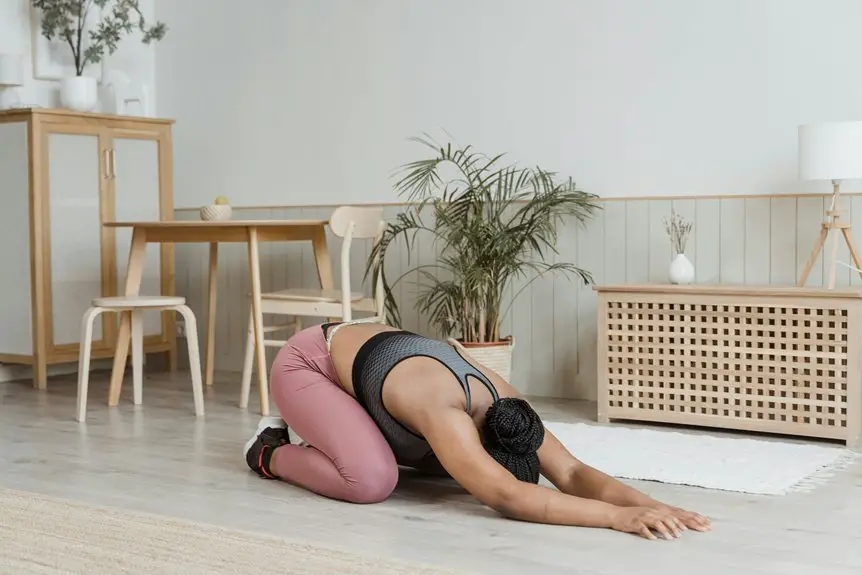When you think about ergonomic chair design, weight distribution might not be the first thing that comes to mind. However, it plays a vital role in your comfort and support during long hours of sitting. By understanding how weight is distributed across the chair, you can significantly enhance your posture and spinal health. But what are the key principles that make this possible? Let's explore how these concepts come together in effective designs.
Table of Contents
Key Takeaways
- Proper weight distribution in ergonomic chairs enhances comfort by reducing pressure points, allowing longer sitting periods without discomfort.
- High-density foam or gel cushioning conforms to body shape, improving weight distribution and overall support.
- Effective weight distribution promotes natural spine alignment, reducing strain on muscles and ligaments for better posture.
- Adjustable features, such as seat height and lumbar support, allow customization for individual body types, enhancing weight distribution and comfort.
- Quality materials, like breathable fabrics and dynamic movement materials, contribute to efficient weight distribution and improved seating experience.
Understanding the Importance of Weight Distribution
When designing an ergonomic chair, understanding weight distribution is crucial because it directly affects comfort and support. You need to consider how your body weight is spread across the chair's surface.
When weight is evenly distributed, it reduces pressure points and minimizes discomfort, enabling you to sit for longer periods without strain. If the chair doesn't support your weight correctly, you might experience fatigue and pain.
A well-designed chair accommodates various body types, ensuring that everyone finds it comfortable. Additionally, proper weight distribution enhances posture, allowing your spine to maintain its natural curve.
Key Principles of Ergonomic Design
When designing an ergonomic chair, you'll want to focus on key principles like posture alignment and pressure distribution.
Proper posture helps reduce strain and supports your spine, while effective pressure distribution techniques keep you comfortable over long periods.
Understanding these principles will enhance your overall seating experience.
Posture Alignment Importance
Posture alignment is crucial for maintaining comfort and preventing injury during long hours of sitting. When your spine is properly aligned, it minimizes strain on muscles and ligaments, allowing you to focus on your tasks without discomfort. An ergonomic chair supports your natural curve, promoting a neutral position.
Here's a quick overview of how posture impacts your work experience:
| Aspect | Importance | Tips for Improvement |
|---|---|---|
| Spine Alignment | Reduces back pain | Adjust chair height |
| Neck Position | Prevents stiffness | Keep monitor at eye level |
| Hip Position | Promotes circulation | Use a footrest if needed |
Pressure Distribution Techniques
Effective pressure distribution techniques are essential for creating an ergonomic chair that enhances comfort and reduces fatigue. You should focus on using materials that provide adequate support while conforming to your body's shape.
A well-designed seat cushion can help distribute your weight evenly, minimizing pressure points that lead to discomfort. Look for adjustable features that allow you to customize support based on your body type and posture.
Additionally, consider the chair's backrest design; it should support your lumbar region and help distribute pressure along your spine.
Lastly, test different chair designs to find one that balances firmness and softness, ensuring that it adapts to your movements throughout the day. Comfort and support go hand in hand for optimal productivity.
Materials That Enhance Weight Distribution
While selecting materials for ergonomic chair design, understanding how they enhance weight distribution is crucial for comfort and support.
Opt for high-density foam or gel cushioning, as these materials conform to your body's shape, evenly distributing weight and reducing pressure points.
Look for breathable fabrics that promote airflow, keeping you cool during long periods of sitting.
Additionally, consider using materials like molded plywood or metal for the chair frame, as they provide stability without adding unnecessary weight.
If you're looking for adjustability, materials that allow for dynamic movement, like elastic mesh, can also contribute to better weight distribution.
Impact on Posture and Spinal Health
Proper weight distribution in your ergonomic chair can significantly enhance your posture and spinal health.
When your chair supports you evenly, it promotes better spinal alignment, reducing strain on your back.
You'll feel the difference in comfort and support as you sit for longer periods.
Proper Weight Distribution
When weight is evenly distributed in an ergonomic chair, it significantly enhances your posture and spinal health.
Proper weight distribution helps you maintain a neutral spine position and reduces strain on your muscles and ligaments.
Here are three key benefits you'll experience:
- Improved Comfort: Balanced weight distribution means no pressure points, allowing you to sit longer without discomfort.
- Reduced Fatigue: When your body isn't working overtime to compensate for poor alignment, you'll feel more energized throughout the day.
- Enhanced Focus: With better posture and less discomfort, your concentration improves, making you more productive.
Choosing a chair that promotes proper weight distribution is vital for your overall well-being and long-term spinal health.
Enhanced Spinal Alignment
Enhanced spinal alignment in an ergonomic chair plays a crucial role in maintaining overall posture and spinal health.
When you sit in a well-designed chair, your spine naturally aligns, reducing pressure on discs and promoting comfort. This alignment helps prevent slouching, which can lead to chronic pain and discomfort.
By supporting the natural curve of your spine, an ergonomic chair encourages you to sit up straight, keeping your muscles relaxed and engaged.
You'll notice that with proper support, you can focus better and reduce fatigue during long hours of sitting.
Investing in an ergonomic chair not only enhances your posture but also contributes to long-term spinal health, ensuring you feel your best throughout the day.
The Role of Adjustability in Ergonomic Chairs
Adjustability plays a crucial role in the effectiveness of ergonomic chairs, as it allows users to customize their seating experience based on individual needs.
When you can fine-tune your chair, it enhances comfort and support, leading to improved productivity.
Here are three key aspects of adjustability that can make a difference:
- Seat Height: Adjusting the height ensures your feet rest flat on the floor, promoting proper posture and reducing strain.
- Lumbar Support: Customizing lumbar support helps maintain the natural curve of your spine, preventing discomfort during long hours.
- Armrests: Adjustable armrests allow you to find the perfect height for your arms, minimizing shoulder tension and enhancing overall comfort.
Case Studies: Successful Weight Distribution Designs
Successful weight distribution designs in ergonomic chairs not only enhance comfort but also promote better posture and reduced fatigue.
For instance, the Steelcase Leap chair utilizes a flexible seat edge that evenly distributes your weight, allowing for natural movement while sitting. Another example is the Herman Miller Aeron chair, which features a unique mesh material that adapts to your body shape, ensuring optimal support.
These chairs encourage proper spinal alignment, reducing strain on your back. You'll also find that the height-adjustable lumbar support in these designs targets your lower back, enhancing comfort during long hours of sitting.
Frequently Asked Questions
How Can I Determine My Ideal Chair Weight Distribution?
To determine your ideal chair weight distribution, sit in various chairs and notice how they feel. Pay attention to comfort and support across your back and legs, adjusting until you find the perfect balance for you.
Are There Specific Brands Known for Better Weight Distribution?
Yes, some brands excel at weight distribution. Look into Herman Miller, Steelcase, and Secretlab; they're recognized for superior ergonomic designs. Try them out to find what suits your needs best. You'll notice the difference!
What Is the Average Lifespan of an Ergonomic Chair?
The average lifespan of an ergonomic chair is typically around 7 to 10 years. However, if you maintain it well and use it properly, it might last even longer, providing you with comfort and support.
How Does Weight Distribution Affect Chair Aesthetics?
Weight distribution impacts chair aesthetics by influencing shape and proportions. When it's balanced, the chair looks sleek and inviting. Poor weight distribution can create awkward designs, making it less visually appealing and uncomfortable for users.
Can Weight Distribution Influence Chair Pricing?
Yes, weight distribution can influence chair pricing. If a design requires advanced materials or technology for optimal weight balance, it typically costs more. You'll notice those premium features reflected in the chair's overall price tag.




